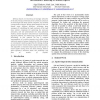Free Online Productivity Tools
i2Speak
i2Symbol
i2OCR
iTex2Img
iWeb2Print
iWeb2Shot
i2Type
iPdf2Split
iPdf2Merge
i2Bopomofo
i2Arabic
i2Style
i2Image
i2PDF
iLatex2Rtf
Sci2ools
126
Voted
ICDE
2007
IEEE
2007
IEEE
Incremental Clustering of Mobile Objects
Moving objects are becoming increasingly attractive to the data mining community due to continuous advances in technologies like GPS, mobile computers, and wireless communication devices. Mining spatio-temporal data can benefit many different functions: marketing team managers for identifying the right customers at the right time, cellular companies for optimizing the resources allocation, web site administrators for data allocation matters, animal migration researchers for understanding migration patterns, and meteorology experts for weather forecasting. In this research we use a compact representation of a mobile trajectory and define a new similarity measure between trajectories. We also propose an incremental clustering algorithm for finding evolving groups of similar mobile objects in spatio-temporal data. The algorithm is evaluated empirically by the quality of object clusters (using Dunn and Rand indexes), memory space efficiency, execution times, and scalability (run time vs. ...
Related Content
| Added | 03 Jun 2010 |
| Updated | 03 Jun 2010 |
| Type | Conference |
| Year | 2007 |
| Where | ICDE |
| Authors | Sigal Elnekave, Mark Last, Oded Maimon |
Comments (0)

